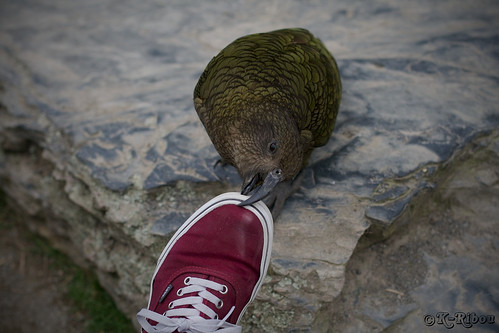 Would Anthraquinone work on shoes we wonder? Image by ClémentSheep are once again being doused in repellent to stop kea from eating them alive.
Would Anthraquinone work on shoes we wonder? Image by ClémentSheep are once again being doused in repellent to stop kea from eating them alive.
Kea Conservation Trust is trialling a repellent, Anthraquinone, on a high-country farm in Queenstown for the second time after the first trial in 2012 proved inconclusive.
Kea use their beaks to dig through a sheep's fleece, hide and flesh in an attempt to find high energy fat - particularly around the sheep's kidney area. The damage can cause death in some sheep.
Over a two-year period on one high country farm near Queenstown about 400 sheep were believed to have died from either a kea attack, or physical trauma from trying to escape the attack or subsequent blood poisoning.
Another year they found 28 dead sheep and a further 25 were "flagged" - where a tuft of wool is pulled up above the rest of the fleece.
"The repellent induces nausea so we are hoping that they would learn that landing on sheep and pecking around is not a good idea," trust chair Tamsin Orr-Walker said.
The repellents are also being trialled to stop the nationally endangered birds from eating 1080 pellets, she said.
The trial involves 600 sheep, 250 of which have been sprayed with the repellent. It also includes acoustic recorders as researchers need to know whether any kea were present, as some sheep may die from other causes.
Orr-Walker said historically kea strike was a problem in autumn and winter when food was more scarce.
"At this time of the year the sheep haven't been shorn and the kea can hang on to the fleeces."
Federated Farmers High Country chairman Chas Todhunter said kea strike had been a problem in a few isolated areas for years. "There are a few properties where it really is an issue and some of them actually lose quite a lot of sheep."
He hoped the trial, which finishes in early June, would be successful as it meant no harm would come to either species.
Orr-Walker said kea were under serious threat with the population in decline.
Several years ago, the government instigated a bounty system for kea to fix the problem on high country farms. An estimated 150,000 kea were killed between 1870 and 1970. Orr-Walker estimates about 5000 remain.
"It's an iconic New Zealand species. It's the only mountain parrot in the world and it's highly intelligent."
She said the kea played an important role in the South Island's eco-system, particularly as it was a massive feed disperser.
Orr-Walker said most people would be familiar with the parrots at places like ski fields and Arthur's Pass, but might not realise how threatened they were.
"[People should] not encourage them into these areas, particularly by roadsides which are just a death trap for these birds."